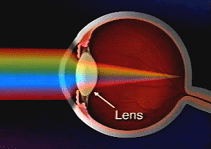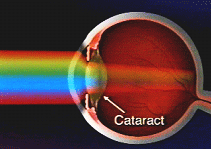|
About Cataracts and Refractive Lens Exchange Cataract is an opacification of the normally crystal-clear lens inside the eye, which causes decreased vision. This is a bilateral condition (affects both eyes), although it is common for one eye to be somewhat worse. The natural lens sits behind the iris (color of the eye) and is responsible for 1/3 of the eye’s focusing power. The lens can also change shape as you attempt to focus up close, allowing for near vision. The ability to see up close slowly diminishes beginning in the mid-forties – a term called presbyopia. In addition, as we age, or after being chronically exposed to certain chemicals (steroids and other medications), the lens loses its clarity and starts yellowing. Everyone who lives long enough will eventually get cataracts, which are the leading cause of reversible blindness in the world. The earliest symptoms of cataracts include: a change in a patient’s glasses prescription; decreased comfort when driving at night; glare, halos, and starburst patterns when looking at lights; and blurred reading vision, especially in dim light (contrast sensitivity loss). With time, these changes worsen, making it increasingly difficult to read in any but the brightest lighting conditions. People often give up driving at night, stop reading as frequently as they would like, and have difficulties discerning colors. Cataract surgery replaces the worn out natural lens with a clear intraocular lens implant (IOL). This outpatient procedure takes about 10 minutes to perform, requires only eye drops for anesthesia, and has a relatively quick recovery time. One eye is operated on at a time, with the second eye’s procedure usually scheduled several days to months after the first eye. The IOL is measured to correct your individual prescription needs. Depending on the type of IOL you choose, cataract surgery can improve both your distance and near vision, often providing freedom from driving and reading glasses! Once the IOL is in place, the vision it provides you does not change over time. Additionally, the material does not cloud up over one’s lifetime. So once you have a cataract or refractive lens exchange procedure, you will never develop cataracts again or require another IOL surgery!
|
||||||


